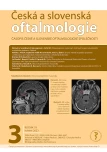OCULAR DISCOMFORT IN PROFESSIONAL POLO-WATER PLAYERS: A PRACTICAL EXPERIENCE WITH TOPICAL HYALURONIC ACID AND GLYCURONATE ENOXOLONE
Autoři:
I. La Mantia 1; P. Bannò 2; P. Scollo 3; G. Ciprandi 4
Působiště autorů:
Otorhinolaryngology Department, University of Catania, Catania, Italy
1; Dieci Decimi Ophthalmological Private Clinic, Catania, Italy
2; Cannizzaro Hospital, Catania, Italy
3; Villa Montallegro Private Hospital, Genoa, Italy
4
Vyšlo v časopise:
Čes. a slov. Oftal., 79, 2023, No. 3, p. 136-140
Kategorie:
Původní práce
doi:
https://doi.org/10.31348/2023/19
Souhrn
Aims: Professional polo-water athletes are exposed to chlorine in the swimming pool. Chlorine is an irritant agent, so polo-water athletes commonly experience irritative eye symptoms. Hyaluronic acid and glycuronate enoxolone exert anti-inflammatory and cytoprotective activity. Therefore, the present practical experience explored the efficacy and safety of eye drops containing both components.
Material and Methods: The current study included 59 professional polo-water athletes. The ocular surface disease index (OSDI) and dry eye-related quality of life (QoL) score (DEQS) questionnaires were used to assess the efficacy. Subjects took the eye drops for one month. The study consisted of a baseline visit (T0) and an end-treatment one (T1).
Results: Athletes experienced a significant improvement in symptoms and QoL as assessed by OSDI and DEQS scores (p < 0.001 for both).
Conclusion: The present study showed that professional polo-water athletes frequently experience ocular discomfort associated with swimming pool attendance. Eye drops with hyaluronic acid and glycuronate enoxolone can significantly relieve eye symptoms and improve the quality of life in these athletes.
Zdroje
1. Stapleton F, Alves M, Bunya VY, et al. TFOS DEWS II Epidemiology Report. Ocul Surf. 2017;15:334-365.
2. Inomata T, Shiang T, Iwagami M, et al. Changes in Distribution of Dry Eye Disease by the New 2016 Diagnostic Criteria from the Asia Dry Eye Society. Sci Rep. 2018:8.
3. Courtin R, Pereira B, Naughton G, et al. Prevalence of dry eye disease in visual display terminal workers: A systematic review and meta-analysis. BMJ Open. 2016;6:e009675.
4. Baradaran-Rafil A, Eslani M, Haq Z, et al. Current and upcoming therapies for ocular surface chemical injuries. Ocul Surf. 2017;15:48-64.
5. Tredici C, Fascianio R, Villano A, et al. Efficacy of eye drops containing crosslinked hyaluronic acid and CoQ10 in restoring ocular health exposed to chlorinated water. Eur J Ophthalmol. 2020;30:430-438.
6. Uchino M, Uchino Y, Dogru M, et al. Dry eye disease and work productivity loss in visual display users: The Osaka Study. Am J Ophthalmol. 2014;157:294-300.
7. Uchino M, Schaumberg DA. Dry Eye Disease: Impact on Quality of Life and Vision. Curr Ophthalmol Rep. 2013;1:51-57.
8. Yu J, Asche CV, Fairchild CJ. The Economic Burden of Dry Eye Disease in the United States: A Decision Tree Analysis. Cornea. 2011;30:379-387.
9. Yamada M, Mizuno Y, Shigeyasu C. Impact of dry eye on work productivity. Clin Outcomes Res. 2012;4:307-312.
10. Tsubota K, Yokoi N, Shimazaki J, et al. New Perspectives on Dry Eye Definition and Diagnosis: A Consensus Report by the Asia Dry Eye Society. Ocul Surf. 2017;15:65-76.
11. Craig JP, Nichols KK, Akpek EK, et al. TFOS DEWS II Definition and Classification Report. Ocul Surf .2017;15:276-283.
12. Miljanovic B, Dana R, Sullivan DA, Schaumberg DA. Impact of dry eye syndrome on vision-related quality of life. Am J Ophthalmol. 2007;143:409-415.
13. Wolsohn JS, Arita R, Chalmers R, et al. TFOS DEWS II Diagnostic Methodology report. Ocul Surf. 2017;15:539-574.
14. Abetz L, Venkataraman K, Mertzanis P, Chalmers R, Begley C. The Development, Reliability, and Validity of a Questionnaire to Assess the Impact of Dry Eyes on Everyday Life (IDEEL). Investig Ophthalmol Vis Sci. 2003;44:2477.
15. Sakane Y, Yamaguchi M, Yokoi N, et al. Development and validation of the Dry Eye-Related Quality-of-Life Score questionnaire. JAMA Ophthalmol. 2013;131:1331-1338.
16. Jung SJ, Mehta JS, Tong L. Effects of environment pollution on the ocular surface. Ocul Surf. 2018;16(2):198-205.
17. Florentin A, Hautemaniere A, Hartemann P. Health effects of disinfection by-products in chlorinated swimming pools. Int J Hyg Environ Health. 2011;214(6):461-469.
18. Ang BCH, Sng JJ, Wang PXH. Sodium hyaluronate in the treatment of dry eye syndrome: a systematic review and meta-analysis. Sci Rep. 2017;7(1):9013.
19. Balestrazzi A, Passali GC, Passali D, Damiani V, Ciprandi G, Balestrazzi E. A new therapeutic approach for the dry eye syndrome in patients with laryngopharyngeal reflux: first data. Acta Biomedica. 2020;91(Suppl. 1):36-42.
20. Ciprandi G, Bellussi ML, Passali GC, Damiani V, Passali D. HMGB1 in nasal inflammatory diseases. A reappraisal 30 years after its discovery. Exp Rev Clin Immunol. 2020;16:457-463.
21. Yang H, Wang H, Andersson U. Targeting inflammation driven by HMGB1. Frontiers Immunol. 2020;11:484.
22. Richard SA. Exploring the pivotal immunomodulatory and anti-inflammatory potentials of glycyrrhizic and glycyrrhetinic acids. Mediators Inflamm. 2021;6699560.
23. Miller KL, Walt JG, Mink DR, et al. Minimally clinically important difference for the Ocular Surface Disease Index. Arch Ophthalmol. 2010;128:94-101.
24. O’Brien PD, Collum LM. Dry eye: diagnosis and current treatment strategies. Curr Allergy Asthma Rep. 2004;4(4):314-319.
25. Ishikawa S, Takeuchi M, Kato N. The combination of strip meniscometry and dry eye-related quality-of-life score is useful for dry eye screening during health checkup: Cross-sectional study. Medicine (Baltimore). 2018;97:e12969.
26. Fukuda M, Miyamoto Y, Miyara Y. Hyaluronic acid concentrations in human tear fluids. Invest Ophthalmol Vis Sci. 1996; 37:S848.
Štítky
OftalmologieČlánek vyšel v časopise
Česká a slovenská oftalmologie

2023 Číslo 3
- Stillova choroba: vzácné a závažné systémové onemocnění
- Diagnostický algoritmus při podezření na syndrom periodické horečky
- Léčba chronické blefaritidy vyžaduje dlouhodobou péči
- Familiární středomořská horečka
- Citikolin jako užitečný pomocník v léčbě diabetické retinopatie a glaukomu
Nejčtenější v tomto čísle
- LASEROVÁ TERAPIE TRHLIN SÍTNICE
- ZMENA VIDENIA DOSPELÝCH PACIENTOV S AMBLYOPIOU PO IMPLANTÁCII VNÚTROOČNEJ ŠOŠOVKY Z REFRAKČNÝCH DÔVODOV
- OBROVSKÝ PROLAKTINÓM. KAZUISTIKA
- ETIOPATOGENEZE SOUČASNÝCH MOŽNOSTÍ TERAPIE SEKUNDÁRNÍHO UVEITICKÉHO GLAUKOMU. PŘEHLED
Zvyšte si kvalifikaci online z pohodlí domova
Současné možnosti léčby obezity
nový kurzVšechny kurzy
